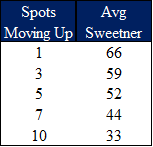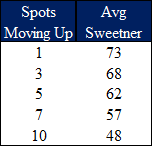What is the cost of trading up in the NHL Draft and does it provide a net benefit to teams that deem a certain talent worthy of moving extra assets to acquire. I used my database of 2,000+ salary cap era trades to isolate 123 around draft day involving only picks. One team trading 2+ picks to get a higher pick, and the eventual NHL GP of those players. The team trading up got more games 54 times, fewer 53 times, and both got zero 16 times (which I thought would be a bigger number, but evidently not). The number of times teams acquired a genuinely impactful player that’s hard to find on the veteran player market is a small fraction of the overall trades.
Before we dig deeper into this subject, we are stuck at 4.2 votes in round 2 of my best NHL contract poll tournament. We only need a few more ballots to legitimize the vote and keep the integrity of this democracy intact. PLEASE VOTE!
Back to the draft; when Atlanta Winnipeg traded Sean Kuraly and Colin Blackwell to move up and pick Zach Yuen, they lost that trade by more than 800 games (and counting), but bottom-six players who aren’t hard to acquire on the open market. It took 7 years before Kuraly was a full-time NHLer, so just looking at total GP shows a lopsided deal, but not necessarily a painful loss for the Thrashers Jets. That trade is actually missing from Kuraly’s hockeydb. They have the Feb 28, 2011 trade where Winnipeg acquired the pick, but he was drafted by the Sharks. Reminder the Hockeydb trade database is incomplete. There are a bunch more. Mine sourced the Pro Sports Transactions website.
Kuraly was a 5th rounder that took 7 years to become a 3rd line NHLer. Getting a top-six forward in R5 is a longshot at best. There were 30 R5 picks in my sample. Sean Kuraly and Jamie Benn are the only ones to top 150 games. That’s 1 Jamie Benn and 1 Sean Kuraly, per 30 fifth round picks. If we shift to the veteran player market, what can you get in current NHLers for a 5th rounder? Vegas traded a 5th to get Chandler Stephenson from Washington. Minnesota traded one to Columbus for Gustav Nyquist. The list drops off after that, Blake Comeau, Drew Stafford, Wayne Simmonds, Zach Sanford, Erik Gudbranson, etc. Not an all-star team, but veteran active players with well over 150 career GP.
That’s a sneak peek at my next NHL Draft post, what picks can buy you on the active player market. That could be combined with this post to try and estimate how many 2nd and 3rd round picks you could accumulate in a single draft day if you were willing to trade down from say, 10 to 40. You tell every other GM you want to trade out of the first round and you’ll listen to every offer all day. The catch being you want the 2nd pick in the deal to be next year’s draft. If you could get 3-4 picks then trade them all for current NHL players before the next draft, you could re-stock your roster getting multiple different players from that first pick. It’s an idea, not sure how well that would work in practice.
Trading into the top 10 using only picks is very rare, but generally those are only moving up a few spots and it’s always a 2nd round pick going back the other way. If you want a top 10 pick and don’t have a nearby pick to flip, you’ll need to send a player. Some examples, Marc Staal, Jordan Staal, Cory Schneider, Derek Stepan, and Alex DeBrincat. In the 3 examples from my sample where there was a pick swap for a top 10, the team trading down received more NHL GP than those trading up. Small sample size, which is somewhat surprising considering how often we hear GMs in June express an interest in moving up in the order.
Trading For Picks 10 to 20
Trading into the middle of round one is significantly more common, with my sample containing 14 with a strong linear relationship between how many spots a team is moving and the average “sweetener” (the next highest pick being sent to move up). Even moving up 1 spot will generally cost a late 2nd or early 3rd, while moving 10 spots will cost another late 1st or early 2nd. The problem being that in 14 trades, the teams trading up got 7,890 GP from the picks while the teams trading down received 9,400. Ottawa sending Chet Pickard and Taylor Beck for Erik Karlsson is easily the most successful trade up example in this range in the entire cap era, possibly ever.
There are more examples in this range of trading down providing a net benefit in NHL GP. San Jose traded Anthony Mantha and Tyler Bertuzzi for Mirco Mueller. Florida traded Derek Forbort to get Jason Zucker and Nick Bjugstad, Columbus traded Kyle Palmieri and Casey Cizikas to get Nick Leddy, etc. If you were trying to trade from 10 to 14 to 18 (as per my multiple trade down idea) you might not have enough buyers. There are 14 of these in 14 drafts, so the supply might not meet your demand. A marketing campaign among your fellow GMs would be required to amplify interest and facilitate the proposed roster re-load.
Trading For Picks 20 to 30
Trading into the bottom of the first round is cheaper and very common; with teams trading up getting 6,700 NHL games and teams trading down getting 7,000. However, that doesn’t mean it’s better to trade down, because one colossal f**k-up by the Toronto Maple Leafs skews it the other way, when they traded Rickard Rakell and John Gibson to Anaheim for Tyler Biggs, which they’ve lost by 1,300 games and counting. At the other end of the spectrum, Islanders trading Ludvig Rensfeldt and Kent Simpson to get Brock Nelson was the best example of trading up in this pick range. Philly traded Gabriel Carlsson and Jeremy Bracco to move up for Travis Konecny.
The gap between pick 20 to 40 (in terms of expected return) is far smaller than the drop-off from pick 1 to 20. The average sweetener tends to be a late 2nd or early 3rd, unless you’re trading up from farther back. This could reflect the market price, or it could be driven by teams with a late first trading their late 2nd to move up a few spots. There were 22 examples in this sample, so roughly 1.5 per draft. Finding dance partners to get picks 22, 25, 28 in my proposed strategy scenario seems more plausible than the previous group.
Trading Up in Round 2
There were 30 trades in my sample where a team moved up for picks 32 to 64, the team moving up received 7,400 NHL games, the teams trading down 5,600. Trading up in the first half of the round averaged picks 48 and 81 coming back, while the bottom half cost picks 76 and 107. Columbus trading Casey Cizikas and Anders Nilsson to the Islanders for Kevin Lynch was the worst example of trading up, next worse was Ottawa trading MacKenzie Blackwood and Joey Anderson for Gabriel Gagne. The best example of trading up is Nashville sending Colby Robak and Tom Sestito to Arizona Utah for Roman Josi. The LA Kings sent Calvin Pickard and Alex Theriau to Colorado for Tyler Toffoli.
If you look at the probability table in my “Drafting top 6 forwards or top 4 defense” post, the probability of a 2nd round pick turning into a top-six forward by age 27 is 17% for wingers and 11% for centers. The probability of a left-shot D being classified “top-four” (not team-by-team, but the 128 best D in the league) is 14%, while right-shot is 22%. The best spot to draft a goalie anywhere in the draft is top half of round 2. Those probabilities aren’t much different for age 23, except for goalies. Enough quality players are selected in this round to sustain market confidence in the value of future R2 selections.
Trading Up in Round 3
Trading down in round three produced the opposite result of round rwo, with the teams trading down getting 6,173 games and those trading up received 4,300. A big chunk of that lopsided score came from Columbus trading Jamie Benn and Auston Smith to move up and take Maxim Mayorov, which they’ve lost by 1,200 games and counting. The next 3 trading down success stories produced James Reimer, Ben Chiarot, and Nick Deslauriers, who are not game changing talents. Trading up produced a lower raw total, but did see more game changers heading their way. The Bruins traded James DeLory and Shane Sims to move up and take Brad Marchand, while Tampa traded Jack Sadek and Louie Belpido to get Brayden Point. Both trades produced Stanley Cup championships (unlike Benn).
On average, teams traded picks 97 and 126 to get pick 80. Your probability of getting a top 6 winger by age 27 in this round is roughly 11%, centers 5%, right D 13%, while left D actually have a higher probability of landing top-four than the previous round. The difference between rounds 2 and 3 is much smaller probability if an impactful player by age 23. The 2nd round picks develop a little faster, but in terms of drafting defense, there is not much significant difference between the rounds. One other observation, picks 76 to 100 is a sneaky great time in the draft to pick goalies, with a higher rate of return than picks 1 to 15 (which is a small sample).
Trading up in rounds 4+
There are 25 trades with teams trading up after pick 96, teams trading up received 2,800 NHL games, teams trading down received 1,800. However, of those 25 trades, teams trading up only received “above replacement” twice, Craig Smith and Phillip Grubauer. The two best players drafted by teams trading down were Dale Weise and the aforementioned Sean Kuraly, who both peaked at slightly above replacement (or not depending on who you talk to and their definition of replacement). At this stage of the draft, getting an above replacement player is low; this sample had 2.5 in 75 picks exchanged. That’s why if you can flip a later pick for a current NHLer is a move I’m supporting much more often than not.
On average teams were moving picks 140 and 159 to get pick 121. Not sure how my fellow draft math nerds will feel about my pessimistic appraisal of using later round picks, or my idea of trading down several times to accumulate mid-round picks for sale on the active player market. My focus here was pick trades before they are drafted, with pessimism focused on the low probability of an impact player. But those picks still have value after the player is chosen and the concept of “selling high” on prospects before everyone else realizes they are just another replacement level player. That will need to be the subject of a future blog post, likely tied to trading undrafted picks for active players in 1-for-1 swaps.







